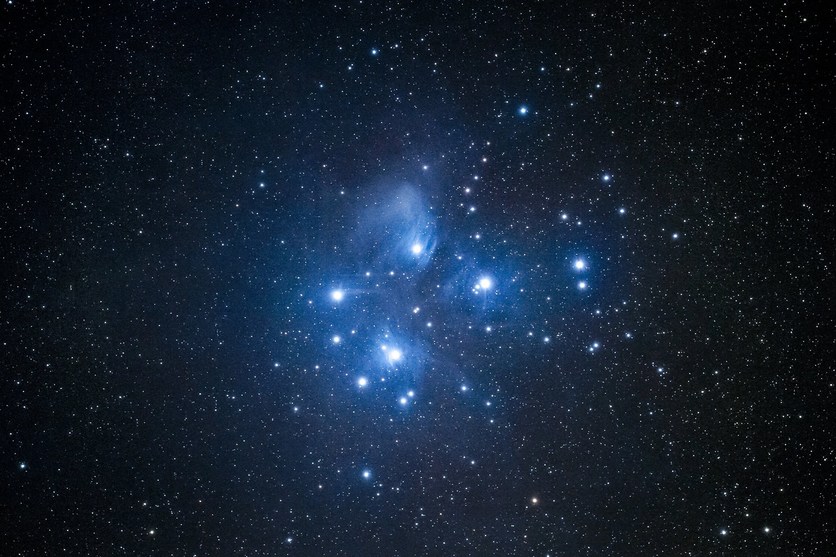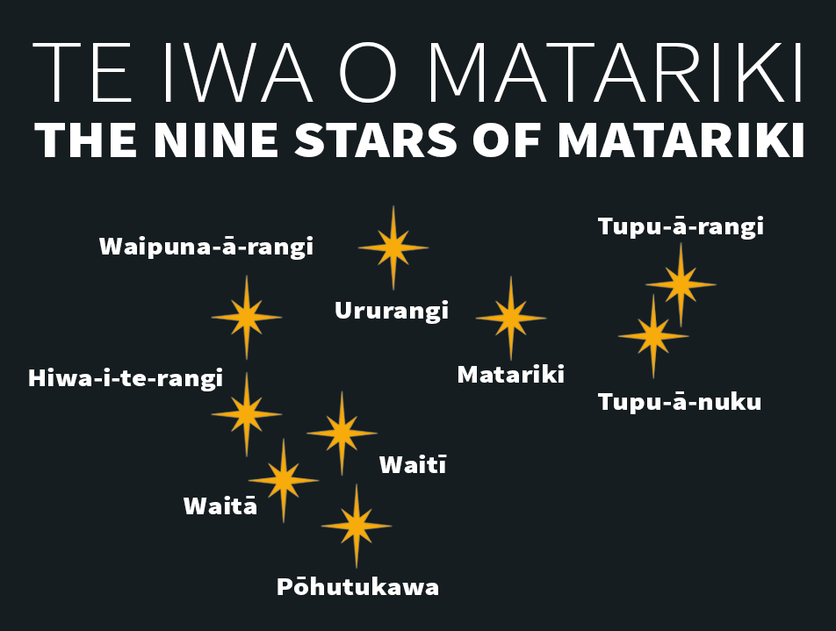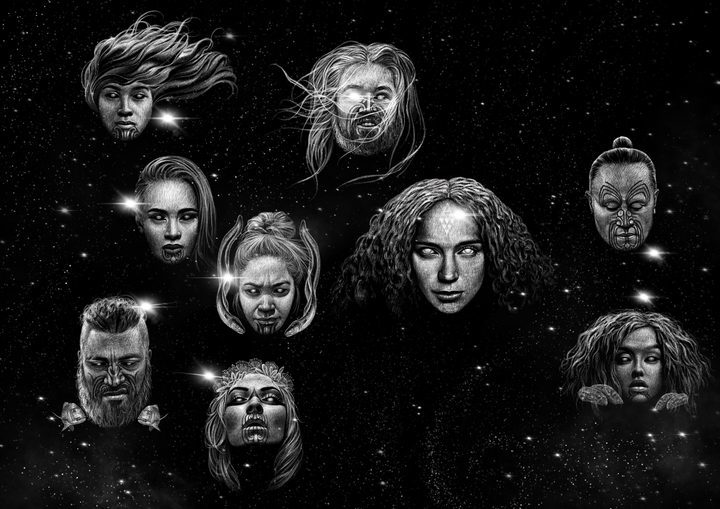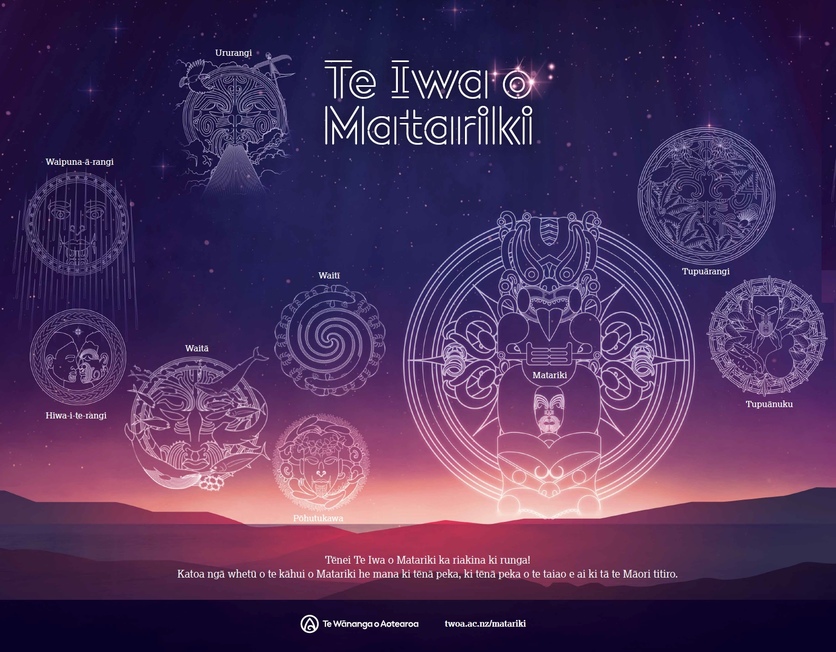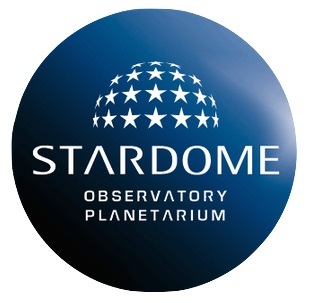Using the Matariki star cluster as a context for learning can cover many different subjects. Matariki is also known as the Pleiades, and it is a widely recognised star cluster around the globe.
Star clusters and constellations
Matariki is a star cluster. Star clusters are groups of stars that are connected – held together – by gravity. A constellation is a group of stars that appear to be close together in an imaginary outline or pattern, but they may actually be very far apart. Māhutonga, also known as the Southern Cross or Crux, is an example of a constellation.
The whetū (stars) in Matariki are relatively young ‘teenage’ stars, born together in a nebula at about the same time. They are much larger than our Sun and are blue because they are hot. Blue stars are the hottest, yellow are medium hot and red stars are at the cooler end of the spectrum.
The hazy white light around the stars that can be seen with a telescope was thought to be the remnants of the nebula the stars came from. However, scientists have discovered that the stars are a little too old to still have remains of the molecular cloud. The hazy light connecting the stars together is a nebula the stars are passing through – the Merope nebula.
Matariki is one of the nearest star clusters to Earth – it’s just 444.2 light years away. The distance to Matariki is used by astronomers as a marker to help calculate distances to other stars. However, measuring the distance has not been without controversy with two different mechanisms measuring two different measurements. Read more in this article: Resolving the Pleiades distance problem.
Te iwa o Matariki
Although there are about a thousand stars in Matariki, nine stars are visible to the unaided eye. In te ao Māori, each of the whetū is associated with an aspect of wellbeing and the environment.
- Matariki (Alcyone) – people’s health and wellbeing
- Tupu-ā-rangi (Atlas) – things that grow up in trees, including fruits, berries and birds
- Waipuna-ā-rangi (Electra) – rainfall
- Waitī (Maia) – freshwater bodies and foods from these waters
- Ururangi (Merope) – the winds
- Tupu-ā-nuku (Pleione) – food that is gathered/harvested from the soil
- Waitā (Taygeta) – the ocean and foods that come from it
- Pōhutukawa (Sterope) – those who have passed on
- Hiwa-i-te-rangi (Calaeno) – attainment of goals.
The positions of the whetū within the cluster are meaningful. For example, Waipuna-ā-rangi and Ururangi are above the other whetū because they represent the rain and the wind. Learn more about the whetū in the activity Naming the whetū in te kāhui o Matariki.
The rising of Matariki
Matariki is visible almost all year except for right before the Matariki celebration starts in June or July. The short time Matariki appears ‘hidden’ from our perspective on Earth, the star cluster is located behind the Sun.
We observe the rising of Matariki in the phase of the Moon called Tangaroa – the moon of plenty. The Moon is a crescent shape, just a few days away from the new moon phase. The date of its rising is predicted using the maramataka Māori – a lunar calendar that is aligned to the phases of the Moon.
Matariki is used to reset the maramataka Māori. The cycle of the Moon around Earth is different to the cycle of Earth around the Sun. The Moon cycle is around 11 days shorter than the solar cycle, meaning that, after 12 months, there are still about 11 days until Earth returns to the same position in its orbit. Stars can be used to reset the lunar calendar because they are in the same place in the sky at the same time in Earth’s orbit. This is why the rising of Matariki isn’t on the same day every year when using a standard 365-day solar calendar.
Māori possess a wealth of astronomical knowledge known as tātai arorangi. They also use the maramataka with each phase of the Moon indicating the favourable times for planting, fishing or eeling.
Other cultures
Matariki is visible in many locations so has lots of names across different cultures. The Greek name is the Pleiades, in Japan it is called Subaru and in China it is Mao, the Hairy Head of the White Tiger of the West.
Stargazing
After Matariki, the star cluster gets easier to see as it rises earlier and earlier in the morning, then later and later at night. The cluster can be found by looking north-east after the festival of Matariki – find Orion’s Belt and follow the three stars across the sky to the left until you find Matariki. Once you find it the first time, you’ll always be able to spot it because of its distinctive grouping. This makes it a great class stargazing exercise.
Related content
Wayfinding is about all of the ways in which people and animals orient themselves in physical space and navigate from place to place. Exploring star constellations is how many people navigated the oceans.
Te Kāhui o Matariki – introduction – curates our Matariki sources in one location!
Environment Aotearoa 2022 uses Matariki as the guiding framework to report on the state of our environment. Each star represents an environmental domain and how it connects to our wellbeing.
The Te Kāhui o Matariki and the environment webinar unpacks ideas connected to the Environment Aotearoa 2022 report and Te Kāhui o Matariki and shares resources that can be used as a guiding framework for teaching and learning.
The webinar Picturebooks for Matariki support teachers to deepen our students and our own understanding of Matariki. The collection Matariki picture books and science contains the resources discussed during this webinar.
Activity ideas
This activity uses online and/or paper-based resources to identify and label the nine whetū in Matariki and learn about their associations with wellbeing and the environment.
Learn about star constellations and the various legends about them.
Continue the adventure with this cross-curricular activity to explore written and visual components of the report’s Matariki representations. Great inspiration for poetry and art!
Useful links
For more helpful information and teaching resources see the Matariki section on the Te Wānanga o Aotearoa website, this includes an option to download the image used above as a poster in English or te reo Māori.
Dr Rangi Matamua is an expert communicator, see below:
- Watch this 2021 recorded webinar Matariki Te Whetū o te Tau on YouTube, run by CORE Education, featuring Rangi.
- In this 2017 Radio NZ radio interview, Matariki - the star of the year, learn about some common misunderstandings of what Matariki is and when it occurs.
- Listen to this podcast from Te Papa Matariki and Māori astronomy – Rangi shares a Māori perspective of astronomical and cosmological links relevant to Matariki.
Read more about the phases of the Moon and Māori planting.
Utilise the free software Stellarium to find the best date and time for your students to go Matariki hunting.
Learn more about Matariki and how it became an official public holiday on the New Zealand Parliament Pāremata Aotearoa website.
Acknowledgement
This article has been written by Stardome Observatory and Planetarium, which has been operating since 1967. It is a place of exploration, research and sharing of knowledge and hosts New Zealand’s first and still largest planetarium theatre. Stardome Observatory and Planetarium celebrates its 50th anniversary in 2017.
